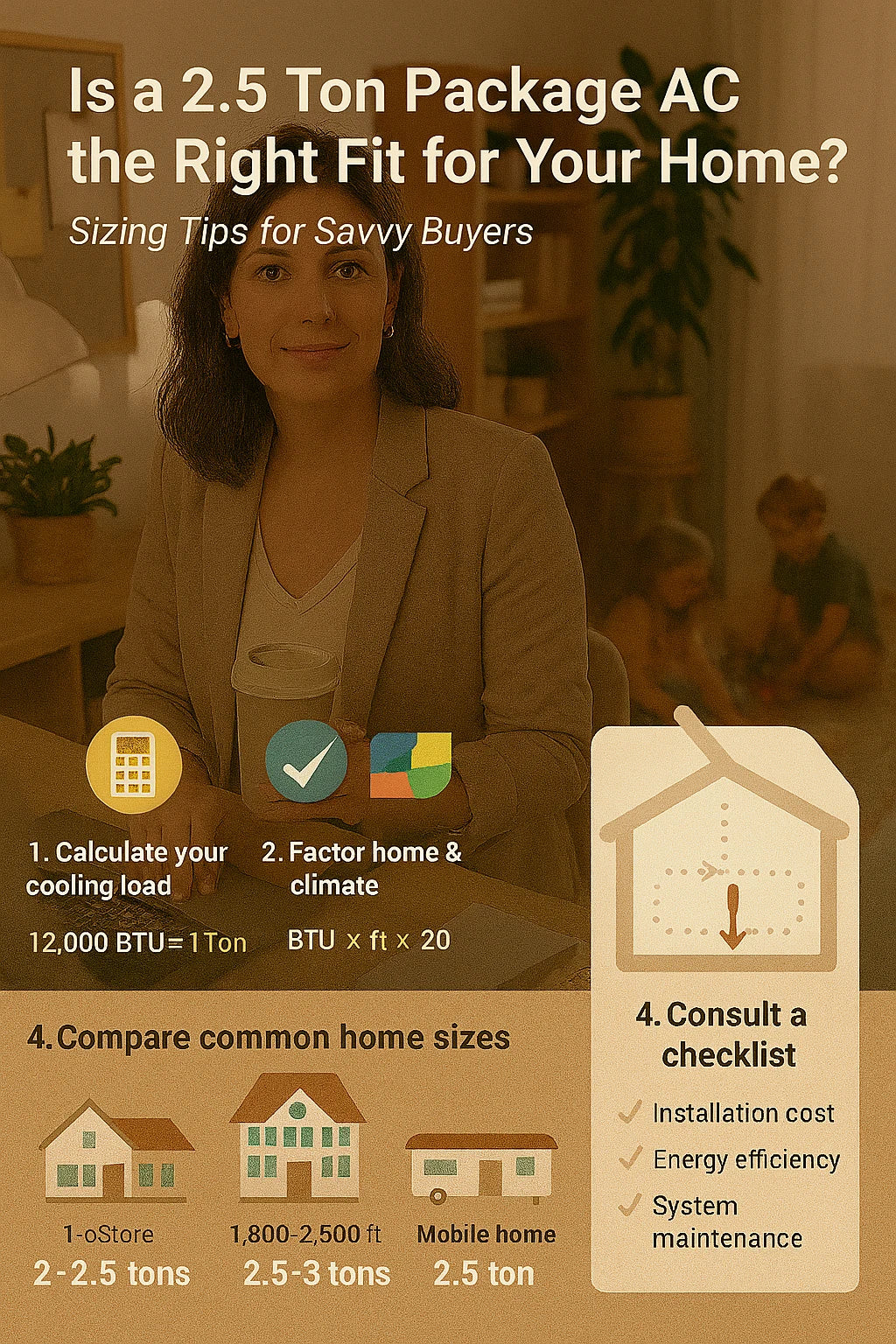🔍 Why Sizing Your AC Correctly Matters
Choosing the right air conditioner size isn't just a matter of comfort—it's a cornerstone of energy efficiency, long-term cost savings, and system durability. Undersized units struggle to cool your space, running constantly and wasting electricity. Oversized units short cycle, leading to poor humidity control, uneven temperatures, and premature wear.
As a rule of thumb, one ton of cooling equals 12,000 BTUs (British Thermal Units). A 2.5-ton unit provides 30,000 BTUs, making it ideal for certain home sizes and layouts—but not all. So, how do you know if it’s right for you?
Expert Insight: According to Better Homes & Gardens, accurate AC sizing improves comfort, energy savings, and air quality.
🏡 Calculate Your Cooling Load: Square Footage & BTUs
The first place to start is with square footage:
-
Typical Rule: 20 BTUs per square foot
-
Formula: Home Area (sq. ft.) x 20 = Total BTUs needed
Example:
-
A 1,500 sq. ft. home x 20 BTUs = 30,000 BTUs → matches a 2.5-ton AC
This works for average homes with standard ceilings, insulation, and sun exposure. But the reality is, most homes don’t follow a perfect template.
Try It Yourself: Use Be Cool Refrigeration's Sizing Calculator to verify your BTU needs.
⚙️ Go Beyond Square Footage: The Key Sizing Factors
To size a 2.5-ton system with confidence, consider these factors:
-
Ceiling Height: Taller rooms need more cooling power.
-
Window Area: More glass = more heat gain.
-
Sun Exposure: South- and west-facing rooms run hotter.
-
Home Insulation: R-values in walls and ceilings matter.
-
Occupancy: More people = more body heat.
-
Appliance Heat Load: Kitchens and electronics boost BTUs.
Resource: Homebuilding & Renovating offers a robust breakdown of these variables.
🔹 Goodman 2.5-Ton Package Unit: Specs That Matter
The Goodman 2.5 Ton 13.4 SEER2 Horizontal Package AC is a self-contained system, meaning everything is housed in one weatherproof cabinet. Here are the essentials:
-
Cooling Capacity: 30,000 BTUs
-
SEER2 Rating: 13.4 (efficient per new 2023+ standards)
-
Refrigerant: R-410A
-
Discharge Type: Horizontal (side airflow)
-
Installation: Ground- or rooftop-mounted
See specs: Alpine Home Air offers similar models for comparison.
🧩 What Home Types Match a 2.5-Ton AC?
A 2.5-ton unit typically cools homes in the 1,400–1,700 sq. ft. range in temperate regions. Here’s how it aligns:
| Home Type | Sq. Ft. | Climate | Match? |
|---|---|---|---|
| 1-Story Ranch | 1,500 | Moderate | ✅ Good Fit |
| 2-Story Colonial | 1,800 | Humid | ❌ May Be Undersized |
| Mobile Home | 1,200 | Hot | ❌ Likely Oversized |
| New Build w/ R-38 | 1,600 | Any | ✅ Great Fit |
Tip: HVACDirect says 2.5-ton units work best in small-to-mid homes with solid insulation (hvacdirect.com).
📊 DIY vs Professional Load Calculations
Manual J Load Calculations are the gold standard for accuracy. These factor:
-
Window U-values
-
Roof insulation
-
Air infiltration
-
Appliance/equipment heat
DIY? Use charts or online tools like Aircondlounge’s BTU Chart. But remember:
| Approach | Pros | Cons |
| DIY | Fast & free | Less precise |
| Manual J | Highly accurate | Requires HVAC pro |
✅ Warning Signs of Improper Sizing
❌ Oversized Units:
-
Short cycling
-
Poor dehumidification
-
Uneven room temps
-
Higher equipment wear
❌ Undersized Units:
-
Constant operation
-
Still feels warm
-
Increased energy bills
-
Compressor stress
Reminder: Better Homes & Gardens warns against oversizing: "You won't save money or get better cooling."
💡 Savvy Buyer Tips: Plan for the Future
-
Think Long-Term: Home additions may need higher tonnage.
-
Thermostat Placement: Avoid sunny walls or vents.
-
Ductwork Health: Clean, sealed ducts = full system performance.
-
Energy Audit: Get a pro to check insulation, leaks, and air flow.
Pro Tip: Smart thermostats like Nest or Ecobee can optimize runtime with real-time load tracking.
🛠️ Efficiency Matters: Installation & SEER2
SEER2, or Seasonal Energy Efficiency Ratio 2, reflects real-world operating efficiency. A SEER2 of 13.4 is compliant in most northern states for packaged units.
-
Proper Install = Performance
-
Clean refrigerant charge
-
Balanced duct airflow
-
Solid insulation in attic/roof deck
-
📄 Final Checklist: Is 2.5 Tons Right for You?
| Question | Yes/No |
| Is your home 1,400–1,700 sq. ft.? | ☑ |
| Moderate-to-hot climate? | ☑ |
| Well-insulated attic & walls? | ☑ |
| Less than 3 full-time occupants? | ☑ |
| South or west-facing rooms? | ❌ (May need upsize) |
If you answered “Yes” to 4 or more: A 2.5-ton Goodman Package Unit may be your ideal match.
📅 Next Steps for Savvy Buyers
-
Use a calculator to confirm your BTU range.
-
Schedule a Manual J audit if your home has unique factors.
-
Compare package vs split system options.
-
Talk to a licensed HVAC contractor about duct design.
In the next topic we will read about: What to Know Before Buying a Self-Contained HVAC Unit: Installation, Access & Layout







